Accidental india
Download as ppt, pdf0 likes312 views
The document summarizes seven key events in India's history since independence according to journalist Shankkar Aiyar's book "Accidental India": 1) The 1991 economic liberalization that opened India's economy after decades of socialism. 2) The Green Revolution of the 1960s that made India self-sufficient in food grains through high-yielding crop varieties and modern farming techniques. 3) The 1969 nationalization of banks to boost lending to rural and small businesses. 4) Operation Flood of the 1970s that transformed India into the largest milk producer through dairy cooperatives. 5) The 1982 mid-day meal scheme to reduce malnutrition and boost school attendance. 6) The software
1 of 10
Download to read offline
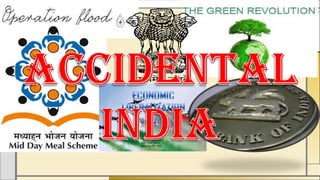
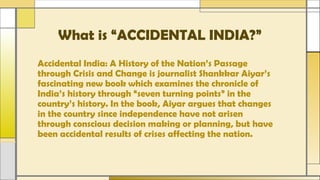
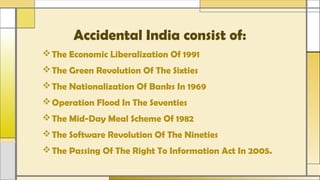

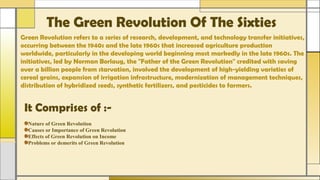
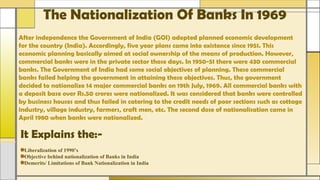
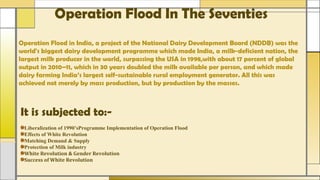
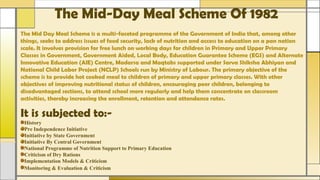


Ad
Recommended
What Does Economics Say About Institutions For Growth
What Does Economics Say About Institutions For Growthessp2
╠²
The document discusses the evolution of the Ethiopian Economics Association (EEA) from its establishment in 1991 to 2012, emphasizing its significant contributions to economic research and policy in Ethiopia. It highlights key achievements, including increased membership, improved resources, and a growing appreciation for economic analysis in policy formulation. The presentation draws lessons on the importance of well-functioning organizations, individual leadership, and the creation of opportunities for institutional growth.Marginalisation and tribals in kerala on the light of globalized era
Marginalisation and tribals in kerala on the light of globalized eraAlexander Decker
╠²
The paper discusses the marginalization of tribal communities in Kerala amidst the backdrop of globalization and the state's development model, highlighting that despite Kerala's notable achievements in human development, tribal populations continue to face socio-economic disadvantages. It argues that the Kerala model of development has excluded and overlooked the needs of tribals, leading to increased deprivation and disparities compared to non-tribal populations. The document also emphasizes how the processes of globalization and local development projects have further aggravated the hardships faced by these marginalized groups.Pnpm tackle inequality problem in indonesian development budiarjo
Pnpm tackle inequality problem in indonesian development budiarjo Researcher Syndicate68
╠²
The document discusses the PNPM (National Program for Community Empowerment) initiated by the Indonesian government to tackle economic inequality and poverty reduction, particularly among marginalized communities. It outlines the program's goals, strategies, and principles while highlighting its implementation challenges and successes since its launch in 2007. The paper emphasizes the need for community involvement and integrated approaches in development to effectively empower the poor and address the growing disparity between social classes in Indonesia.Economics chapter 2
Economics chapter 2Navratan Sharma
╠²
- The document provides an overview of the Indian economy between 1950-1990, focusing on the objectives and implementation of the five-year plans, agriculture reforms including land reforms and the Green Revolution, as well as policies around industrialization and trade.
- Key aspects discussed include the establishment of the Planning Commission in 1950 to oversee five-year plans aimed at economic growth, equity, employment, self-reliance, and modernization. Agriculture reforms such as high-yield variety seeds and land reforms helped boost production, while problems around credit and marketing remained. The Green Revolution saw increased outputs but also issues like ecological degradation and income disparities. Industrial policy emphasized public sectors and import substitution.Example Tap Dance Controlled Assessment
Example Tap Dance Controlled AssessmentDebden Park High School
╠²
This document provides information about tap dance, including:
- A comparison of Gene Kelly's tap performance in "Singin' in the Rain" from the 1940s.
- Basic rules and equipment for tap dancing, including the proper shoes and attire.
- A brief history of tap dance's origins and rise in popularity during the 1900s.
- Terminology used for various tap dance moves from the 1940s to today.
- Videos and analyses of the author performing tap dance skills and comparing their performance to a "perfect model."Economic reforms
Economic reformsdebanjanbanerjee18
╠²
India has pursued gradual economic reforms since independence in 1947 to develop its economy. Reforms in the early decades focused on self-sufficiency and developing infrastructure and agriculture through public sector investment and five-year plans. Liberalization began in the 1980s under Rajiv Gandhi and accelerated in 1991 when Manmohan Singh initiated reforms encouraging foreign investment, privatizing public sectors, and developing services. While India was impacted by the global recession, it was able to withstand effects better than others due to government regulation of some financial sectors. Current reforms aim to further strengthen banking and exports.Liberalization, growth and regional disparities in india
Liberalization, growth and regional disparities in indiaSpringer
╠²
The chapter reviews India's economic policies and growth performance since independence in three periods: 1950-1980, 1980-1991, and post-1991. During 1950-1980, import substitution and public sector-led industrialization were emphasized. Agriculture grew slowly initially but the Green Revolution boosted output after the 1960s. 1980-1991 saw some liberalization, including delicensing of industries, but agriculture saw no major policy changes. Economic reforms accelerated after 1991 with widespread deregulation and liberalization.Economic reforms and agriculture growth of india
Economic reforms and agriculture growth of indiaKishanChauhan39
╠²
The document discusses the impact of economic reforms in India in 1991 on the agricultural sector. It notes that prior to 1991, agriculture was the largest employer in India and the government provided subsidies and protection. The economic crisis of 1990 led to reforms involving liberalization, privatization, and globalization (LPG policies). This affected the agricultural sector through reduced subsidies, spending on rural development and infrastructure, financial reforms limiting rural credit, and trade liberalization. While the reforms aimed to boost agriculture, the sector actually saw declining growth rates, investment, and terms of trade. Rural incomes and food security were adversely impacted. Overall, the reforms exposed farmers to greater risks while reducing government support.Indian economy pre-1991 reforms with globalization
Indian economy pre-1991 reforms with globalizationShlomoh Samuel
╠²
The document outlines the economic history of India from pre-colonial times to the 1990s, highlighting the decline of India's economy due to British colonization and the subsequent shift towards economic protectionism post-independence. It notes significant reforms initiated in the 1990s under Dr. Manmohan Singh, aiming to liberalize and open up India's economy to foster growth and competitiveness. Key issues addressed include unsustainable government expenditures, inflation, and the recommendations from the World Bank and IMF which prompted the adoption of the New Economic Policy.5 year plans in INDIA
5 year plans in INDIAjyothireddy562
╠²
The document outlines the history and objectives of India's five-year plans initiated in 1951, detailing their focus on various sectors like agriculture, industry, and social justice over different periods. Each plan has specific goals tailored to the needs of the economy, such as poverty alleviation, employment generation, and technological advancement. The document also discusses the role of the Planning Commission and the impact of these plans on India's economic growth and development.Economic development
Economic developmentNaga Muruga
╠²
Pandit Nehru adopted a mixed economy model for India after independence to balance capitalism and socialism. This included public, private, and joint sectors. Five Year Plans were established to address poverty, unemployment, and economic development. The Plans focused on agriculture, industry, employment, and standards of living. Nationalization of banks in the 1960s and 1970s aimed to promote development. India liberalized its economy in 1991 under PM Narasimha Rao and FM Manmohan Singh in response to an economic crisis, adopting policies of privatization, liberalization, and globalization. This included opening to foreign investment and joining the World Trade Organization in 1995.5 year plan ppt 2
5 year plan ppt 2Aliya Siddiqua
╠²
The document provides an overview of India's five-year plans from the first plan in 1951 to the ninth plan ending in 2002. Some key points covered include:
- The first plan focused on improving agriculture and irrigation projects. The second plan emphasized industry and heavy industry.
- Subsequent plans addressed various goals like poverty alleviation, employment, self-reliance, modernization, and increasing productivity in key sectors like agriculture.
- Economic reforms began in the early 1990s during a period of political instability, liberalizing the socialist economy and opening up to international trade. The eighth plan undertaken reforms to correct debt and deficits.India's 5 year plan startegy
India's 5 year plan startegyNits Kedia
╠²
The document provides details about India's various five-year plans from the first plan in the 1950s to the ninth plan in the late 1990s-early 2000s. It summarizes the key goals and outcomes of each successive plan, including a focus on agriculture in early plans, developing industry and infrastructure in later plans, and gradually opening India's economy through reforms in the 1990s.Foreign trade composition
Foreign trade compositionUjjwal 'Shanu'
╠²
The document provides an overview of foreign trade in India. It discusses the composition, importance, direction, and balance of India's foreign trade. Some key points:
- Each country tries to increase goods/services availability through imports and sells surpluses through exports. Currencies must be mutually acceptable.
- Foreign trade is important for economic development, meeting shortages, improving living standards, and utilizing resources.
- India's major imports are fuels, capital goods, chemicals and food grains. Exports are manufactured goods, textiles, gems and jewelry.
- India's major export partners are OECD, OPEC and developing countries. Major import partners are OECD countries, OPEC andPre 1990 Indian Economy
Pre 1990 Indian EconomyYasmin Hussain
╠²
The pre-1990 Indian economy was characterized by a strong emphasis on protectionism, import substitution, and central planning. India's share of world income declined from 22.3% in 1700 to 3.8% by 1952 due to British colonial rule. After independence, the government prioritized heavy industry and public sector growth through five-year plans but saw limited success. Reforms began in the 1990s with liberalization of trade and investment policies to address fiscal and balance of payments crises, opening India's economy to globalization. Major reforms included trade liberalization, privatization, tax changes, and incentives for foreign investment and exports.Manufacuting
Manufacutingbsmihd
╠²
This document provides an overview of industrial policy in India from 1950 to the present. It discusses how India was one of the first developing countries to implement an industrial policy after World War II to coordinate public and private investment and bring strategic industries under public ownership. This model held sway from 1950-1980 but began eroding in the 1980s and changed fundamentally after an economic crisis in 1991. However, the document argues industrial policy has continued in a different form and still faces challenges in achieving equitable and sustainable growth while leveraging opportunities in areas like information and communication technology. It examines the historical models, economic growth trends, role of services, and implications for future industrial policy approaches in India.Five year-plans-of-india
Five year-plans-of-indiaKakumanu Jabilli
╠²
The document summarizes key details from India's first seven Five Year Plans between 1951-1989. The plans aimed to improve living standards, increase GDP growth, develop infrastructure like roads and railways, and make progress in agriculture, industry and social services. While objectives were largely achieved, challenges included high inflation, drought, and slowing economic progress at times due to global or domestic political issues. The plans laid the foundation for India's economy and self-sufficiency in important areas.Green Revolution
Green Revolutionshreya11099
╠²
Agriculture before the Green Revolution was limited by lack of irrigation and technology, resulting in low and unpredictable crop yields. This caused global concerns about the ability to feed growing populations. After independence, India established agricultural institutions and saw some improvements but productivity remained low. The Green Revolution starting in the 1960s introduced high-yielding varieties of wheat and rice, irrigation projects, and chemical fertilizers, doubling food production in India and alleviating famine concerns. Agricultural advances after the Green Revolution continued to increase yields and crop diversification.Contempry issue yogita
Contempry issue yogitaNazakat Ali Khan
╠²
The document discusses the economic reforms in India that began in the early 1990s known as Liberalization, Privatization and Globalization (LPG model). The reforms aimed to make the Indian economy more efficient and globally competitive by liberalizing industries, trade, and the financial sector. This marked India's real integration into the global economy and a shift away from the self-reliant, socialist policies after independence. The reforms have helped spur economic growth but also increased economic disparities.Five Year Plan (Indian Economy).pptx reference presentation
Five Year Plan (Indian Economy).pptx reference presentationtutejaruchi123
╠²
The document outlines the history and evolution of India's five-year plans from 1951 to 2017, detailing their objectives, growth targets, and achievements. It highlights the transition from the Planning Commission to NITI Aayog, and emphasizes the key focuses of each five-year plan, such as industrialization, agricultural development, poverty alleviation, and social equity. The document concludes with a reflection on the importance of economic planning and the limitations of centralized planning in India's diverse context.Foreign trade composition
Foreign trade compositionUjjwal 'Shanu'
╠²
The document discusses key aspects of India's five year plans from 1951-1985. The first plan focused on developing the agricultural sector and increasing food production. Subsequent plans emphasized industry, infrastructure like dams and power plants, education, poverty alleviation and self-reliance. Defense needs interrupted some plans. Plans also aimed to strengthen the economy, boost growth rates and increase incomes.Indian economy
Indian economyanushkaranade
╠²
The document discusses the economic history of India from 1950 to 1990, highlighting its mixed economy structure that combines elements of both capitalism and socialism. It examines various aspects such as economic planning, the goals of the five-year plans, agricultural advancements like the Green Revolution, and the role of industrial development and trade policy in shaping the economy. Critical evaluations are made regarding the successes and drawbacks of industrial and financial policies during this period.5 years plan in india
5 years plan in indiaKishan Bang
╠²
The document summarizes the key aspects of India's first 11 five-year plans from 1951 to 1997. The first plan focused on improving agriculture, while the second emphasized industry and heavy industry. Subsequent plans addressed various economic goals like poverty alleviation, employment, self-reliance, and modernization. Major events like wars and changes in government impacted the plans. The plans played a key role in India's transition from a closed to a more open and liberalized economy.FIVE YEAR PLANS OF INDIA
FIVE YEAR PLANS OF INDIAPraveen Mukati
╠²
The document provides details about India's five-year plans from 1951-2012. It summarizes the key goals and outcomes of each five-year plan, including improving agriculture (1st plan), developing industry (2nd plan), increasing electricity and irrigation projects (3rd plan), nationalizing banks and responding to wars (4th plan), focusing on employment and self-reliance (5th plan), expanding infrastructure and tourism (6th plan), improving productivity (7th plan), economic reforms (8th plan), generating employment and reducing poverty (9th plan), increasing access to education and clean water (10th plan), accelerating GDP growth and employment (11th plan).Presentation on Economic Development
Presentation on Economic DevelopmentJLoknathDora
╠²
The document discusses India's economic development from mixed economy principles post-independence to the adoption of globalization in the 1990s. It outlines various Five-Year Plans aimed at self-sufficiency, poverty alleviation, and industrial growth, alongside the challenges faced by workers, particularly in the textile sector. Notably, it details the New Economic Policy initiated in 1991 under Prime Minister P. V. Narasimha Rao and Finance Minister Dr. Manmohan Singh, which linked the Indian economy with the global market.13 chapter7
13 chapter7Shweta Vaghela
╠²
- Even after 55 years of planned development and 9 Five-Year Plans, India has failed to solve basic economic problems like poverty and unemployment. Poverty has increased and the benefits of development have mostly gone to affluent sections.
- Gandhi advocated for a rural-based, agriculture-focused model of development to uplift rural populations, but this was not implemented. Instead, Nehru adopted a Western model of heavy industrialization through centralized planning.
- While the goals of early plans were to reduce poverty and establish a socialist society, the benefits have not reached poorer sections. Later poverty programs were poorly designed and funds were misused, providing only acknowledgement but not solutions for the poor.causes of poverty in India
causes of poverty in IndiaGaurang Asopa
╠²
1. Poverty in India has many causes stemming from British colonial rule, including deindustrialization which led many artisans to abandon their professions and take up agriculture, increasing pressure on land.
2. The British policy of permanent land settlements and revenue collection impoverished peasants by creating absentee landlords with no incentive to invest in agriculture while peasants had to pay high rents, taxes, and interest to moneylenders.
3. Commercialization of agriculture in the late 1800s linked Indian farmers to volatile international markets, and they saw few benefits while facing risks of falling prices and debt.Thegreenrevolutioninindia 090420180040-phpapp01
Thegreenrevolutioninindia 090420180040-phpapp01annusingh595
╠²
The Green Revolution in India introduced new high-yielding crop varieties that required significant chemical inputs to increase agricultural yields, but had unforeseen social, political, and environmental consequences. While yields initially increased dramatically, production plateaued and then declined as soils lost nutrients. Dependence on external inputs impoverished small farmers and degraded the land. Rising economic and cultural tensions, combined with rural inequality, exacerbated ethnic and religious divisions and even sparked violent unrest in Punjab. The revolution changed relationships between farmers and the environment in ways that had wide-ranging political impacts.EDSA Revolution and Democracy - the Youth and Students in Focus [uploadable]....
EDSA Revolution and Democracy - the Youth and Students in Focus [uploadable]....ssuser0e98111
╠²
This presentation talks about the EDSA Revolution and Democracy in general and its context with the youth.More Related Content
Similar to Accidental india (20)
Indian economy pre-1991 reforms with globalization
Indian economy pre-1991 reforms with globalizationShlomoh Samuel
╠²
The document outlines the economic history of India from pre-colonial times to the 1990s, highlighting the decline of India's economy due to British colonization and the subsequent shift towards economic protectionism post-independence. It notes significant reforms initiated in the 1990s under Dr. Manmohan Singh, aiming to liberalize and open up India's economy to foster growth and competitiveness. Key issues addressed include unsustainable government expenditures, inflation, and the recommendations from the World Bank and IMF which prompted the adoption of the New Economic Policy.5 year plans in INDIA
5 year plans in INDIAjyothireddy562
╠²
The document outlines the history and objectives of India's five-year plans initiated in 1951, detailing their focus on various sectors like agriculture, industry, and social justice over different periods. Each plan has specific goals tailored to the needs of the economy, such as poverty alleviation, employment generation, and technological advancement. The document also discusses the role of the Planning Commission and the impact of these plans on India's economic growth and development.Economic development
Economic developmentNaga Muruga
╠²
Pandit Nehru adopted a mixed economy model for India after independence to balance capitalism and socialism. This included public, private, and joint sectors. Five Year Plans were established to address poverty, unemployment, and economic development. The Plans focused on agriculture, industry, employment, and standards of living. Nationalization of banks in the 1960s and 1970s aimed to promote development. India liberalized its economy in 1991 under PM Narasimha Rao and FM Manmohan Singh in response to an economic crisis, adopting policies of privatization, liberalization, and globalization. This included opening to foreign investment and joining the World Trade Organization in 1995.5 year plan ppt 2
5 year plan ppt 2Aliya Siddiqua
╠²
The document provides an overview of India's five-year plans from the first plan in 1951 to the ninth plan ending in 2002. Some key points covered include:
- The first plan focused on improving agriculture and irrigation projects. The second plan emphasized industry and heavy industry.
- Subsequent plans addressed various goals like poverty alleviation, employment, self-reliance, modernization, and increasing productivity in key sectors like agriculture.
- Economic reforms began in the early 1990s during a period of political instability, liberalizing the socialist economy and opening up to international trade. The eighth plan undertaken reforms to correct debt and deficits.India's 5 year plan startegy
India's 5 year plan startegyNits Kedia
╠²
The document provides details about India's various five-year plans from the first plan in the 1950s to the ninth plan in the late 1990s-early 2000s. It summarizes the key goals and outcomes of each successive plan, including a focus on agriculture in early plans, developing industry and infrastructure in later plans, and gradually opening India's economy through reforms in the 1990s.Foreign trade composition
Foreign trade compositionUjjwal 'Shanu'
╠²
The document provides an overview of foreign trade in India. It discusses the composition, importance, direction, and balance of India's foreign trade. Some key points:
- Each country tries to increase goods/services availability through imports and sells surpluses through exports. Currencies must be mutually acceptable.
- Foreign trade is important for economic development, meeting shortages, improving living standards, and utilizing resources.
- India's major imports are fuels, capital goods, chemicals and food grains. Exports are manufactured goods, textiles, gems and jewelry.
- India's major export partners are OECD, OPEC and developing countries. Major import partners are OECD countries, OPEC andPre 1990 Indian Economy
Pre 1990 Indian EconomyYasmin Hussain
╠²
The pre-1990 Indian economy was characterized by a strong emphasis on protectionism, import substitution, and central planning. India's share of world income declined from 22.3% in 1700 to 3.8% by 1952 due to British colonial rule. After independence, the government prioritized heavy industry and public sector growth through five-year plans but saw limited success. Reforms began in the 1990s with liberalization of trade and investment policies to address fiscal and balance of payments crises, opening India's economy to globalization. Major reforms included trade liberalization, privatization, tax changes, and incentives for foreign investment and exports.Manufacuting
Manufacutingbsmihd
╠²
This document provides an overview of industrial policy in India from 1950 to the present. It discusses how India was one of the first developing countries to implement an industrial policy after World War II to coordinate public and private investment and bring strategic industries under public ownership. This model held sway from 1950-1980 but began eroding in the 1980s and changed fundamentally after an economic crisis in 1991. However, the document argues industrial policy has continued in a different form and still faces challenges in achieving equitable and sustainable growth while leveraging opportunities in areas like information and communication technology. It examines the historical models, economic growth trends, role of services, and implications for future industrial policy approaches in India.Five year-plans-of-india
Five year-plans-of-indiaKakumanu Jabilli
╠²
The document summarizes key details from India's first seven Five Year Plans between 1951-1989. The plans aimed to improve living standards, increase GDP growth, develop infrastructure like roads and railways, and make progress in agriculture, industry and social services. While objectives were largely achieved, challenges included high inflation, drought, and slowing economic progress at times due to global or domestic political issues. The plans laid the foundation for India's economy and self-sufficiency in important areas.Green Revolution
Green Revolutionshreya11099
╠²
Agriculture before the Green Revolution was limited by lack of irrigation and technology, resulting in low and unpredictable crop yields. This caused global concerns about the ability to feed growing populations. After independence, India established agricultural institutions and saw some improvements but productivity remained low. The Green Revolution starting in the 1960s introduced high-yielding varieties of wheat and rice, irrigation projects, and chemical fertilizers, doubling food production in India and alleviating famine concerns. Agricultural advances after the Green Revolution continued to increase yields and crop diversification.Contempry issue yogita
Contempry issue yogitaNazakat Ali Khan
╠²
The document discusses the economic reforms in India that began in the early 1990s known as Liberalization, Privatization and Globalization (LPG model). The reforms aimed to make the Indian economy more efficient and globally competitive by liberalizing industries, trade, and the financial sector. This marked India's real integration into the global economy and a shift away from the self-reliant, socialist policies after independence. The reforms have helped spur economic growth but also increased economic disparities.Five Year Plan (Indian Economy).pptx reference presentation
Five Year Plan (Indian Economy).pptx reference presentationtutejaruchi123
╠²
The document outlines the history and evolution of India's five-year plans from 1951 to 2017, detailing their objectives, growth targets, and achievements. It highlights the transition from the Planning Commission to NITI Aayog, and emphasizes the key focuses of each five-year plan, such as industrialization, agricultural development, poverty alleviation, and social equity. The document concludes with a reflection on the importance of economic planning and the limitations of centralized planning in India's diverse context.Foreign trade composition
Foreign trade compositionUjjwal 'Shanu'
╠²
The document discusses key aspects of India's five year plans from 1951-1985. The first plan focused on developing the agricultural sector and increasing food production. Subsequent plans emphasized industry, infrastructure like dams and power plants, education, poverty alleviation and self-reliance. Defense needs interrupted some plans. Plans also aimed to strengthen the economy, boost growth rates and increase incomes.Indian economy
Indian economyanushkaranade
╠²
The document discusses the economic history of India from 1950 to 1990, highlighting its mixed economy structure that combines elements of both capitalism and socialism. It examines various aspects such as economic planning, the goals of the five-year plans, agricultural advancements like the Green Revolution, and the role of industrial development and trade policy in shaping the economy. Critical evaluations are made regarding the successes and drawbacks of industrial and financial policies during this period.5 years plan in india
5 years plan in indiaKishan Bang
╠²
The document summarizes the key aspects of India's first 11 five-year plans from 1951 to 1997. The first plan focused on improving agriculture, while the second emphasized industry and heavy industry. Subsequent plans addressed various economic goals like poverty alleviation, employment, self-reliance, and modernization. Major events like wars and changes in government impacted the plans. The plans played a key role in India's transition from a closed to a more open and liberalized economy.FIVE YEAR PLANS OF INDIA
FIVE YEAR PLANS OF INDIAPraveen Mukati
╠²
The document provides details about India's five-year plans from 1951-2012. It summarizes the key goals and outcomes of each five-year plan, including improving agriculture (1st plan), developing industry (2nd plan), increasing electricity and irrigation projects (3rd plan), nationalizing banks and responding to wars (4th plan), focusing on employment and self-reliance (5th plan), expanding infrastructure and tourism (6th plan), improving productivity (7th plan), economic reforms (8th plan), generating employment and reducing poverty (9th plan), increasing access to education and clean water (10th plan), accelerating GDP growth and employment (11th plan).Presentation on Economic Development
Presentation on Economic DevelopmentJLoknathDora
╠²
The document discusses India's economic development from mixed economy principles post-independence to the adoption of globalization in the 1990s. It outlines various Five-Year Plans aimed at self-sufficiency, poverty alleviation, and industrial growth, alongside the challenges faced by workers, particularly in the textile sector. Notably, it details the New Economic Policy initiated in 1991 under Prime Minister P. V. Narasimha Rao and Finance Minister Dr. Manmohan Singh, which linked the Indian economy with the global market.13 chapter7
13 chapter7Shweta Vaghela
╠²
- Even after 55 years of planned development and 9 Five-Year Plans, India has failed to solve basic economic problems like poverty and unemployment. Poverty has increased and the benefits of development have mostly gone to affluent sections.
- Gandhi advocated for a rural-based, agriculture-focused model of development to uplift rural populations, but this was not implemented. Instead, Nehru adopted a Western model of heavy industrialization through centralized planning.
- While the goals of early plans were to reduce poverty and establish a socialist society, the benefits have not reached poorer sections. Later poverty programs were poorly designed and funds were misused, providing only acknowledgement but not solutions for the poor.causes of poverty in India
causes of poverty in IndiaGaurang Asopa
╠²
1. Poverty in India has many causes stemming from British colonial rule, including deindustrialization which led many artisans to abandon their professions and take up agriculture, increasing pressure on land.
2. The British policy of permanent land settlements and revenue collection impoverished peasants by creating absentee landlords with no incentive to invest in agriculture while peasants had to pay high rents, taxes, and interest to moneylenders.
3. Commercialization of agriculture in the late 1800s linked Indian farmers to volatile international markets, and they saw few benefits while facing risks of falling prices and debt.Thegreenrevolutioninindia 090420180040-phpapp01
Thegreenrevolutioninindia 090420180040-phpapp01annusingh595
╠²
The Green Revolution in India introduced new high-yielding crop varieties that required significant chemical inputs to increase agricultural yields, but had unforeseen social, political, and environmental consequences. While yields initially increased dramatically, production plateaued and then declined as soils lost nutrients. Dependence on external inputs impoverished small farmers and degraded the land. Rising economic and cultural tensions, combined with rural inequality, exacerbated ethnic and religious divisions and even sparked violent unrest in Punjab. The revolution changed relationships between farmers and the environment in ways that had wide-ranging political impacts.Recently uploaded (18)
EDSA Revolution and Democracy - the Youth and Students in Focus [uploadable]....
EDSA Revolution and Democracy - the Youth and Students in Focus [uploadable]....ssuser0e98111
╠²
This presentation talks about the EDSA Revolution and Democracy in general and its context with the youth.the pay postcode lottery event slides.pdf
the pay postcode lottery event slides.pdfResolutionFoundation
╠²
the pay postcode lottery event slides.pdfVijay Rupani Biography: Early Life, Education, and Political Career
Vijay Rupani Biography: Early Life, Education, and Political CareerVoterMood
╠²
Explore the biography of Vijay RupaniÔÇöhis early life, academic background, and rise in Indian politics through the ranks of the BJP.UPSC Officers News & Insights: WhoÔÇÖs Moving Where in Indian Administration.pdf
UPSC Officers News & Insights: WhoÔÇÖs Moving Where in Indian Administration.pdfharshitbaisla73
╠²
This comprehensive PDF brings you the latest updates on UPSC officers' transfers, promotions, and key administrative reshuffles across India. From IAS to IPS movements, track whoÔÇÖs moving where and how these changes impact governance and public administration. Whether you're a civil service aspirant, policy analyst, or simply an informed citizen, this document offers valuable insights into the dynamic world of Indian bureaucracy. Stay ahead with verified details, departmental highlights, and expert observations.POLITICAL AND RELIGIOUS ASPECTS OF POWER IN INDIA
POLITICAL AND RELIGIOUS ASPECTS OF POWER IN INDIAAnushka Singh
╠²
DESCRIBES INTERSECTION OF THE POLITICAL AND RELIGIOUS ASPECTS OF POWER IN INDIAPathos Communications When Reputation Management Becomes Reputation Destructi...
Pathos Communications When Reputation Management Becomes Reputation Destructi...nathaniel leonard
╠²
A recent letter from UK-based firm Pathos Communications: When Reputation Management Becomes Reputation DestructionGatwick AG About A Company Shut Down by UK Courts Still Sells Offshore Servic...
Gatwick AG About A Company Shut Down by UK Courts Still Sells Offshore Servic...nathaniel leonard
╠²
Gatwick AG was dissolved by British authorities in 2023. Its website remains active. And former clients say theyÔÇÖve been misled and defrauded.
PRESS-RELEASE-WIFE-3.pdfKen Ofori-Atta undergoes successful prostate cancer s...
PRESS-RELEASE-WIFE-3.pdfKen Ofori-Atta undergoes successful prostate cancer s...businessweekghana
╠²
Ken Ofori-Atta undergoes successful prostate cancer surgery ÔÇô Wife disclosesAir India Plane Crash: Tragedy Strikes Near Ahmedabad
Air India Plane Crash: Tragedy Strikes Near AhmedabadNew India Abroad
╠²
The Air India Plane Crash on June 12, 2025, shocked the nation and the global Indian community. A Boeing 787-8 Dreamliner, carrying 242 passengers and crew, crashed shortly after taking off from Ahmedabad Airport, on route to London. The aircraft struck a hostel near B.J. Medical College, causing fatalities both onboard and on the ground. Investigations are ongoing, focusing on possible engine failure. One Indian-origin British passenger survived. Families worldwide are mourning this tragic Air India Plane Crash, and New India Abroad continues to provide in-depth coverage on the disaster and its far-reaching impact.╬ƒ╬╣ ¤ç¤Ä¤ü╬Á¤é ¤ä╬À¤é ╬ò¤à¤ü¤Ä¤Ç╬À¤é ╬╝╬Á ¤ä╬À╬¢ ╬║╬▒╬╗¤ì¤ä╬Á¤ü╬À ¤Ç╬┐╬╣¤î¤ä╬À¤ä╬▒ ¤à╬┤╬¼¤ä¤ë╬¢ ╬│╬╣╬▒ ╬║╬┐╬╗¤ì╬╝╬▓╬À¤â╬À ÔÇô ╬ù ╬©╬¡¤â╬À╠²¤ä...
╬ƒ╬╣ ¤ç¤Ä¤ü╬Á¤é ¤ä╬À¤é ╬ò¤à¤ü¤Ä¤Ç╬À¤é ╬╝╬Á ¤ä╬À╬¢ ╬║╬▒╬╗¤ì¤ä╬Á¤ü╬À ¤Ç╬┐╬╣¤î¤ä╬À¤ä╬▒ ¤à╬┤╬¼¤ä¤ë╬¢ ╬│╬╣╬▒ ╬║╬┐╬╗¤ì╬╝╬▓╬À¤â╬À ÔÇô ╬ù ╬©╬¡¤â╬À╠²¤ä...Newsroom8
╠²
┬½╬ò╬¥╬▒╬╣¤ü╬Á¤ä╬╣╬║╬«¤é ¤Ç╬┐╬╣¤î¤ä╬À¤ä╬▒¤é┬╗ ¤ä╬┐ 97% ¤ä¤ë╬¢ ¤à╬┤╬¼¤ä¤ë╬¢ ╬║╬┐╬╗¤ì╬╝╬▓╬À¤â╬À¤é ¤â¤ä╬À╬¢ ╬ò╬╗╬╗╬¼╬┤╬▒. ╬ñ╬╣ ╬▒╬¢╬▒¤å╬¡¤ü╬Á╬╣ ╬¡╬║╬©╬Á¤â╬À ╬│╬╣╬▒ ¤ä╬À╬¢ ╬ò¤à¤ü¤Ä¤Ç╬À ╬║╬▒╬╣ ¤ä╬▒ ¤â¤ä╬┐╬╣¤ç╬Á╬»╬▒ ╬│╬╣╬▒╠²¤ä╬À╠²¤ç¤Ä¤ü╬▒╠²╬╝╬▒¤é.Kerala a hotspot for ISIS recruitment.pdf
Kerala a hotspot for ISIS recruitment.pdfAaryan Kansari
╠²
Kerala: A Hotspot for ISIS Recruitment ÔÇô Intelligence Primer.
This comprehensive intelligence primer explores KeralaÔÇÖs emergence as IndiaÔÇÖs primary hotspot for ISIS recruitment and radicalization between 2014 and 2025. Drawing from law enforcement data, NIA charge sheets, and field research, the presentation analyzes major cases, key figures, affected districts (Kannur, Malappuram, Kasaragod), and the drivers behind radicalization including Gulf migration, online Malayalam propaganda, and local organizational networks. It covers landmark operations like Operation Pigeon, high-profile cases such as Rashid Abdulla and Nimisha alias Fathima, and the role of groups like PFI. The report also highlights recent developments, module busts, and the stateÔÇÖs counter-radicalization strategies, offering actionable insights for intelligence professionals, policymakers, and researchers.Indian Community Centers ÔÇô New India Abroad
Indian Community Centers ÔÇô New India AbroadNew India Abroad
╠²
New India Abroad highlights the vital role of Indian community centers in uniting the global Indian diaspora. These centers offer cultural programs, language classes, legal support, and social events, helping immigrants stay connected to their roots while integrating abroad. Found in cities like New York, London, and Toronto, Indian community centers foster belonging and cultural pride. New India Abroad proudly showcases their impact, promoting unity, tradition, and support across Indian communities worldwide.
TCS to set up IT facility housing 10k employees in Vizag: Nara Lokesh
TCS to set up IT facility housing 10k employees in Vizag: Nara Lokeshnarsireddynannuri1
╠²
TCS to set up IT facility housing 10k employees in Vizag: Nara Lokesh
In a major boost to Andhra PradeshÔÇÖs burgeoning IT sector, Tata Consultancy Services (TCS), one of IndiaÔÇÖs leading IT services and consulting companies, is set to establish a new facility in Visakhapatnam (Vizag), which will accommodate up to 10,000 employees. The announcement was made by Nara Lokesh, the former Minister of Information Technology for Andhra Pradesh, who has been instrumental in driving the stateÔÇÖs IT growth in recent years. This development marks a significant milestone for the city of Vizag, further positioning it as a key player in IndiaÔÇÖs IT ecosystem.
For TCS, setting up a facility in Vizag is a strategic move aligned with its ongoing expansion plans in Tier-II cities. Vizag, often called the "City of Destiny," has emerged as a prime destination for IT companies due to its favorable infrastructure, connectivity, and skilled talent pool. With TCS expanding into this coastal city, the company aims to leverage these advantages, enhance its operational efficiencies, and tap into a less saturated but equally capable workforce compared to Tier-I cities like Bengaluru and Hyderabad. Moreover, Vizag offers a cost advantage over larger cities, making it an attractive location for companies looking to optimize expenses while ensuring access to top-tier talent. This development also supports TCSÔÇÖs broader goals of decentralizing its operations across India, which not only reduces dependency on major IT hubs but also contributes to the holistic growth of the nationÔÇÖs digital infrastructure. Nara Lokesh highlighted the project as a significant step toward transforming Vizag into a leading IT hub. The proposed facility will generate employment for thousands of skilled professionals in the region, offering opportunities in software development, digital consulting, data analytics, and other high-demand IT services. Its capacity of 10,000 employees is evidence of the scale of the operation which will provide a major boost to the local economy. The job creation that comes with the TCS facility will benefit IT professionals and have a ripple effect on other sectors such as real estate, retail, and services. The influx of workers is expected to drive demand for housing, transportation, and other amenities, further spurring economic growth in the region. VizagÔÇÖs rise as an IT hub is part of a broader effort by the Andhra Pradesh government to attract global and domestic IT giants to invest in the state. The TDP government has been offering various incentives, such as land allocations, subsidies, and infrastructure support, to encourage companies to set up shop in the region. The city already hosts several IT parks and Special Economic Zones (SEZs), and TCSÔÇÖs arrival will only strengthen its position on the national IT map. Furthermore, VizagÔÇÖs proximity to educational institutions such as Andhra University provides a steady stream of qualified graduates, making it an idealHOW TO ELIMINATE THE EVILS AGAINST HUMANITY CAUSED BY CAPITALISM THROUGHOUT H...
HOW TO ELIMINATE THE EVILS AGAINST HUMANITY CAUSED BY CAPITALISM THROUGHOUT H...Faga1939
╠²
This article aims to present how to eliminate the evils against humanity caused by capitalism by contributing to: 1) the devastation of nature that causes pandemics to proliferate and affect the health of the world's population; 2) global warming and catastrophic global climate change since the Industrial Revolution in England that affect the health and living conditions of the world's population; 3) the proliferation of wars and even the possibility of the outbreak of World War III that could lead to the extinction of humanity and life on Earth; 4) making the world economy chaotic and compromising the social well-being of humanity; and, 5) the advance of neo-fascism in the world. To eliminate the evils caused by capitalism, it is necessary to build in each country the Welfare State along the lines of the Scandinavian model of social democracy as a transition to democratic socialism and establish, on a global level, a global democratic Government, a global Parliament and a global Supreme Court.Connecting the Indian Community Abroad ÔÇô New India Abroad
Connecting the Indian Community Abroad ÔÇô New India AbroadNew India Abroad
╠²
New India Abroad is dedicated to strengthening the global Indian community by sharing inspiring stories, news, and achievements of Indians living overseas. We highlight their contributions across business, culture, science, and public service. Whether it's entrepreneurship in the U.S. or academic success in Europe, New India Abroad brings their journeys to light. Our mission is to foster unity, pride, and a shared identity among the vibrant Indian community abroad, helping them stay informed and connected.╬ƒ╬╣ ¤ç¤Ä¤ü╬Á¤é ¤ä╬À¤é ╬ò¤à¤ü¤Ä¤Ç╬À¤é ╬╝╬Á ¤ä╬À╬¢ ╬║╬▒╬╗¤ì¤ä╬Á¤ü╬À ¤Ç╬┐╬╣¤î¤ä╬À¤ä╬▒ ¤à╬┤╬¼¤ä¤ë╬¢ ╬│╬╣╬▒ ╬║╬┐╬╗¤ì╬╝╬▓╬À¤â╬À ÔÇô ╬ù ╬©╬¡¤â╬À╠²¤ä...
╬ƒ╬╣ ¤ç¤Ä¤ü╬Á¤é ¤ä╬À¤é ╬ò¤à¤ü¤Ä¤Ç╬À¤é ╬╝╬Á ¤ä╬À╬¢ ╬║╬▒╬╗¤ì¤ä╬Á¤ü╬À ¤Ç╬┐╬╣¤î¤ä╬À¤ä╬▒ ¤à╬┤╬¼¤ä¤ë╬¢ ╬│╬╣╬▒ ╬║╬┐╬╗¤ì╬╝╬▓╬À¤â╬À ÔÇô ╬ù ╬©╬¡¤â╬À╠²¤ä...Newsroom8
╠²
Ad
Accidental india
- 2. What is ÔÇ£ACCIDENTAL INDIA?ÔÇØ Accidental India: A History of the NationÔÇÖs Passage through Crisis and Change is journalist Shankkar AiyarÔÇÖs fascinating new book which examines the chronicle of IndiaÔÇÖs history through ÔÇ£seven turning pointsÔÇØ in the countryÔÇÖs history. In the book, Aiyar argues that changes in the country since independence have not arisen through conscious decision making or planning, but have been accidental results of crises affecting the nation.╠²
- 3. Accidental India consist of: ´üÂThe Economic Liberalization Of 1991 ´üÂThe Green Revolution Of The Sixties ´üÂThe Nationalization Of Banks In 1969 ´üÂOperation Flood In The Seventies ´üÂThe Mid-Day Meal Scheme Of 1982 ´üÂThe Software Revolution Of The Nineties ´üÂThe Passing Of The Right To Information Act In 2005.
- 4. The Economic Liberalization Of 1991 The economic liberalization in India refers to ongoing economic reforms in India that started on 24 July 1991. After Independence in 1947, India adhered to socialist policies. Attempts were made to liberalize the economy in 1966 and 1985. The first attempt was reversed in 1967. Thereafter, a stronger version of socialism was adopted. The second major attempt was in 1985 by prime minister Rajiv Gandhi. The process came to a halt in 1987, though 1966 style reversal did not take place It Includes:- Pre Liberalization Policies Narasimha Rao Government (1991ÔÇô1996) Later Reforms Impact Of Pre Liberalization Policy Impact Of Reforms
- 5. The Green Revolution Of The Sixties ╠²Green Revolution refers to a series of research, development, and technology transfer initiatives, occurring between the 1940s and the late 1960s that increased agriculture production worldwide, particularly in the developing world beginning most markedly in the late 1960s. The initiatives, led by Norman Borlaug, the "Father of the Green Revolution" credited with saving over a billion people from starvation, involved the development of high-yielding varieties of cereal grains, expansion of irrigation infrastructure, modernization of management techniques, distribution of hybridized seeds, synthetic fertilizers, and pesticides to farmers. It Comprises of :- Nature of Green Revolution Causes or Importance of Green Revolution Effects of Green Revolution on Income Problems or demerits of Green Revolution
- 6. The Nationalization Of Banks In 1969 ╠²After independence the Government of India (GOI) adopted planned economic development for the country (India). Accordingly, five year plans came into existence since 1951. This economic planning basically aimed at social ownership of the means of production. However, commercial banks were in the private sector those days. In 1950-51 there were 430 commercial banks. The Government of India had some social objectives of planning. These commercial banks failed helping the government in attaining these objectives. Thus, the government decided to nationalize 14 major commercial banks on 19th July, 1969. All commercial banks with a deposit base over Rs.50 crores were nationalized. It was considered that banks were controlled by business houses and thus failed in catering to the credit needs of poor sections such as cottage industry, village industry, farmers, craft men, etc. The second dose of nationalisation came in April 1980 when banks were nationalized. It Explains the:- Liberalization of 1990ÔÇÖs Objective behind nationalization of Banks in India Demerits/ Limitations of Bank Nationalization in India
- 7. Operation Flood In The Seventies Operation Flood in India, a project of the National Dairy Development Board (NDDB) was the world's biggest dairy development programme which made India, a milk-deficient nation, the largest milk producer in the world, surpassing the USA in 1998,with about 17 percent of global output in 2010ÔÇô11, which in 30 years doubled the milk available per person, and which made dairy farming IndiaÔÇÖs largest self-sustainable rural employment generator. All this was achieved not merely by mass production, but by production by the masses. It is subjected to:- Liberalization of 1990ÔÇÖsProgramme Implementation of Operation Flood Effects of White Revolution Matching Demand & Supply Protection of Milk industry White Revolution & Gender Revolution Success of White Revolution
- 8. The Mid-Day Meal Scheme Of 1982 The Mid Day Meal Scheme is a multi-faceted programme of the Government of India that, among other things, seeks to address issues of food security, lack of nutrition and access to education on a pan nation scale. It involves provision for free lunch on working days for children in Primary and Upper Primary Classes in Government, Government Aided, Local Body, Education Guarantee Scheme (EGS) and Alternate Innovative Education (AIE) Centre, Madarsa and Maqtabs supported under Sarva Shiksha Abhiyan and National Child Labor Project (NCLP) Schools run by Ministry of Labour. The primary objective of the scheme is to provide hot cooked meal to children of primary and upper primary classes. With other objectives of improving nutritional status of children, encouraging poor children, belonging to disadvantaged sections, to attend school more regularly and help them concentrate on classroom activities, thereby increasing the enrollment, retention and attendance rates. It is subjected to:- History Pre Independence Initiative Initiative by State Government Initiative By Central Government National Programme of Nutrition Support to Primary Education Criticism of Dry Rations Implementation Models & Criticism Monitoring & Evaluation & Criticism
- 9. The Software Revolution of 90ÔÇÖs The free software movement was launched in 1983, but there existed earlier projects which fit (or almost fit) the modern definition of free software, that is, software which all users are free to use, study, modify and redistribute ("free as in freedom"). Earlier projects provided these freedoms either for practical reasons or social reasons but were not part of an organized movement to spread the practice or the philosophy. The movement was launched by Richard Stallman as a reaction to the growing trend of developers blocking these freedoms by only publishing the run able version of the software and not the modifiable source code. Stallman argues that this is a social imperative for all distributed software, rather than a technical choice which just happens to have a practical value in some contexts. In 1998, people who advocated free software but disagreed that it was a social imperative began using the term "open-source software" for the software and presenting it as having technical advantages. It includes:- Sharing Techniques Before Software Free Software Before the 1980ÔÇÖs Initial Decline of Free Software Conditions Between 1980ÔÇÖs ÔÇô 1990ÔÇÖs Launch of Free Software Movement
